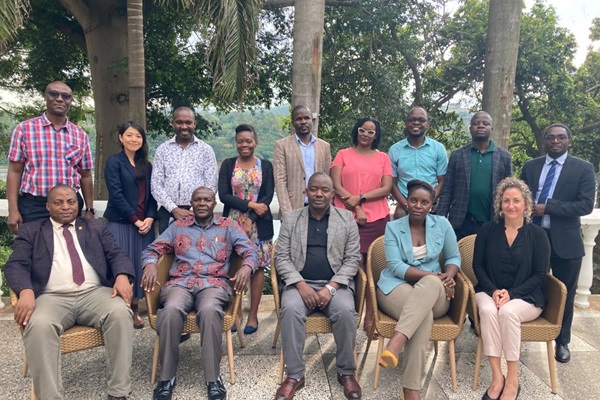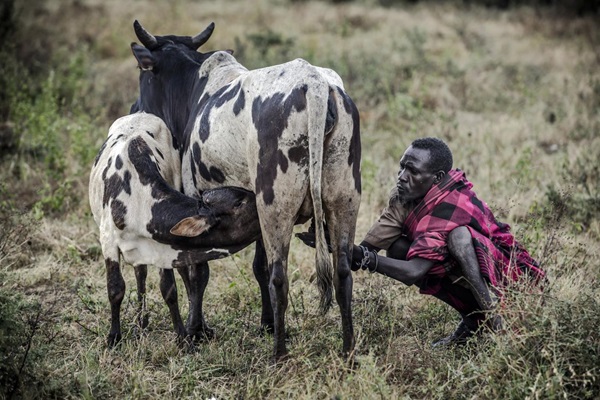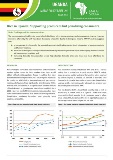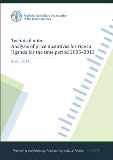Uganda

Agrifood policy monitoring
Actual agriculture-specific expenditures in Uganda from 2004–2017 stood at an average of USD 143 million, with the lowest of the period being USD 85 million in 2005, the highest being around USD 309 in 2017.
In the last 5 years (2013–2017), budgeted amounts stood at an average of USD 338 million, while actual spending stood at USD 193 million, implying a budget execution rate of 58%. This was mainly driven by low execution rate of donor-funded projects.
Uganda’s agriculture expenditure progress was still below the CAADP 10% target. Between 2004 and 2017, the share of agriculture spending over total public expenditure ranged from the lowest 3.3% in 2016 to the highest 5.9% in 2009, with an annual average over the period of 4.9%.
In the last 5 years, on average nearly all (94%) of all expenditures were funded by the government, while the rest (6%) was financed by donors.
On average, in the same period, the vast majority (89%) of actual agriculture-specific expenditure was directed towards the general-sector support to the sector (i.e. public goods such as research, extension and infrastructure), followed by a small share (10%) to producers in the form of input subsidies, and just under 1% to consumers (e.g. food, subsidies and school-meals programmes).
* in USD nominal terms
Price incentives at the farm-gate measured by the nominal rate of protection (NRP) – the percentage difference between domestic and international equivalent price – averaged 11% across all 9 commodities (beef, cassava, coffee, cotton, maize, milk, rice, sugarcane, and tea) between 2005 and 2022. However, substantial differences exist among these commodities:
- Cotton and rice farmers have consistently benefited from price incentives, averaging 45% and 49%, respectively. These positive figures suggest favourable market conditions and/or policies that enhance farmers' income by ensuring better prices.
- Tea farmers, conversely, faced consistent negative price incentives averaging -46%, and this could be due to market distortions and/or unfavourable policies affecting the sector.
- Beef and sugarcane farmers transitioned from receiving negative price incentives in the past, to positive incentives in recent years. For instance, beef farmers went from averaging -28% on average (2011–2016) averaging 77% incentives (2017–2020). Similarly, sugarcane shifted from averaging -36% disincentives (2005–2013) to 43% incentives (2014–2022). This shift suggests improvements in market dynamics, policy interventions or a combination of both, potentially enhancing the profitability for farmers.
- Cassava, milk, coffee, and maize farmers experienced fluctuations between negative price incentives and positive incentives. However, on average, cassava, milk, and coffee farmers faced price disincentives of -11%, -10%, and -9% respectively. Overall, maize farmers benefited from positive price incentives averaging 42%, with significant variations, ranging from -36% in 2012 to 158% in 2021. Several factors could explain fluctuating price incentives, including changes in demand and supply dynamics, fluctuations in international prices, among others.
Agrifood policy prioritization
MAFAP is collaborating with the National Planning Authority and the Ministry of Agriculture, Animal Industry and Fisheries, to generate evidence to help prioritize agricultural commodities for the Agro-Industrialization Programme in the upcoming Fourth National Development Plan (NDP IV) of Uganda, 2025–2030.
Through the use of an economy-wide model developed by MAFAP, this work aims to explore the potential impact that alternative scenarios of public investment in Uganda’s agricultural sectors/commodities would have on productivity thus triggering changes in several priority socioeconomic indicators of the government, such as boosting agri GDP, reducing rural poverty, creating jobs, and giving greater access to healthy diets.
Current agrifood policy support
In collaboration with AgrInvest Uganda (FAO’s Investment Centre), MAFAP is supporting the EU-funded “Developing a market-oriented and environmentally sustainable beef meat industry in Uganda” Project (MOBIP) and the Beef Policy/Advocacy Taskforce (led by Uganda’ Agribusiness Alliance, UAA) to identify policy issues and solutions in Uganda’s beef sub-sector.
MAFAP conducted two analyses: 1) one on beef meat export competitiveness and export potential to new markets and 2) another on price incentives along the value chain.
The findings from the studies and policy recommendations have been discussed and operationalized by the National Beef Platform, which drafted a Beef Policy Advocacy Action Plan in 2022. The recommendations have been included in the UAA’s submission to the Presidential Advisory Committee on Exports and Industrial Development (PACEID) on measures to accelerate Uganda’s agrifood export growth.
These recommendations focus on a review of standards and grades for beef products, establishment of an integrated livestock market information system (inclusive of cattle/meat identification and traceability, and animal health, quality and price information), establishment of a public private partnership for the production, procurement and distribution of veterinary drugs including Foot-and-Mouth Disease (FMD) vaccines.
The Dairy Development Authority (DDA), the body that regulates the dairy sector, requested MAFAP's technical assistance to assess the export competitiveness of Ugandan milk and dairy products. This analysis aims to identify new potential markets, and to make recommendations on related policy interventions, regulations and public investments with a view to harness the export potential of the country's dairy products.
The recommendations have been taken up and are now being included in a new action guide for dairy exports, due to be published in Q1 2024.
Following a request by the Ministry of Gender, Labour and Social Development and its National Task Force on Labour Productivity Enhancement, MAFAP is currently undertaking an analysis to assess the binding constraints to agricultural labour productivity.
This support seeks to estimate agricultural labour productivity across sectors (i.e. crops, livestock, and fisheries), locations and time, and to identify main drivers and constraints (e.g. physical, technological, environmental, etc.); in order to make recommendations to inform the agriculture-focused section of the upcoming National Productivity Policy.
Uganda's Ministry of Trade, Industry and Cooperatives (MoTIC) requested MAFAP's support to identify priority policy interventions to design a Marketing Strategy under the Parish Development Model.
For this support, MAFAP is producing a situation analysis of agricultural marketing to characterize key problems and opportunities that can be addressed by the Marketing Strategy, identify priority policy interventions to include in the Marketing Strategy, and support the MoTIC in drafting the Marketing Strategy implementation plan, including capabilities and resources needed, and a timeline to put it into place.
Agrifood reforms
In collaboration with AgrInvest Uganda (FAO’s Investment Centre), MAFAP is supporting Uganda’s Dairy Development Authority (DDA) to collate, identify and analyze evidence-based policy issues and related solutions in the dairy sub-sector.
MAFAP collaborated in 4 different studies initiated in 2021: i.e. Price incentives analysis for dairy, Domestic per-capita milk consumption estimates, Performance of Milk Collection Centres and Post-harvest loss in the milk and dairy value chain.
The findings from the studies and recommended policy interventions have been discussed and operationalized by the dairy multi-stakeholder platform, involving key private and public stakeholders in the dairy value chain. Multiple regional and national stakeholders’ workshops culminated in the sector's new Dairy Policy Action Plan (DPAP), which was formally endorsed by the DDA in August 2022 to guide policy, planning and investment decisions in this promising sub-sector.
News

MAFAP supports Uganda’s forests through public spending review
09/11/2023

MAFAP team meet with Ugandan partners for agriculture labour productivity study and commodity investment prioritization
09/11/2023

MAFAP strengthens support to Uganda’s dairy sector on World Milk Day (1 June)
01/06/2023
Publications

Rice in Uganda: Supporting producers but penalizing consumers
02/04/2013
Rice farmers and traders in Uganda receive higher prices thanks to existing policies. However, rice consumers also pay higher prices since they do not...
National partners
- Ministry of Agriculture, Animal Industry and Fisheries
- Ministry of Finance, Planning and Economic Development
- Ministry of Trade, Industry and Cooperatives
- Ministry of Gender, Labour and Social Development
- National Planning Authority
- Dairy Development Authority
- International Growth Centre Uganda
Useful links
Contact the MAFAP Uganda team

Cabrel Nana Nkuingoua
Policy Analyst


